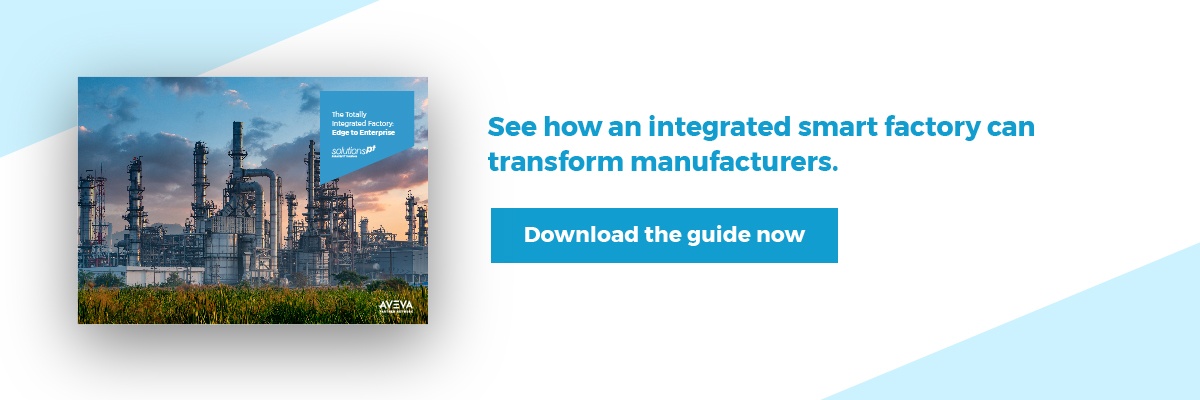Research carried out by LNS found that the top three objectives manufacturers hope to achieve today are:
- Ensuring consistent quality of products.
- Responsiveness to customer order demands.
- Increasing production capacity and capabilities.
All three focus on the ability to better serve customers to ensure they remain loyal. Without this loyalty, there’s nothing to stop them from taking their business elsewhere. But what are the obstacles preventing these objectives and how can an unified operations approach ensure they’re successful?
- Improving Collaboration to Enable Operations
- Bringing Together the Connected World and the Smart Factory
- A Unified Operations Centre
Improving Collaboration to Enable Operations
The same research from LNS found the biggest obstacle to meeting the top objectives was a lack of collaboration across different departments.
Siloed working hinders productivity and growth which is why organisations are looking to improve their flow of information. Regardless of whether you’re trying to collect data from another team or site, the manufacturing process doesn’t need to be complicated or time-consuming.
Greater collaboration and operational agility can be achieved by the Industrial Internet of Things (IIoT) and its convergence with OT.
IIoT technology offers a competitive edge by enabling easy data collection from disparate sources. Information can come from within the factory or from across the supply chain.
Even if different sites aren’t operating on the same equipment brands and processes, it’s possible to present a collection of integrated IOT devices and common services including visualisation, communication, security, data connectivity, data storage and management into a single platform.
This gives staff a transparent look at all areas of the site, enabling fast and flexible responses to real-life events. Plus, it’s easy to pick out key details, spot patterns and identify root causes to uncover potential areas of improvement.
Bringing Together the Connected World and the Smart Factory
Deploying Fog Architecture
Physical constraints might mean fog architecture and edge technology are the only viable solutions you have. It could be that you can’t tolerate the latency of transmitting to the cloud and back again or the delay in data sharing is causing problems. But it still offers the possibility to use the cloud to do some heavy lifting tasks such as AI and big data analytics.
With a fog architecture in place, there’s less burden on human workers to carry out difficult judgements. With the right technology, they can receive the relevant data they need to make confident, growth-driven decisions. The more we embrace the Industrial IoT, the more we’ll see digital alternatives taking on repetitive, menial tasks.
Extending Connectivity Through the Supply Chain
This vital connectivity can extend beyond the factory floor which allows for traceability of all activities. This includes everything from where raw materials are sourced to where products are delivered to customers.
Data Collection and AI
Collecting data from not only plant sources but also from IOT sensors that sit outside the factory or from systems that aren't connected to the factory control system, like environmental monitoring systems.
Adding Value to OT
It’s now possible to augment existing OT systems with low-cost IIoT without the need to install expensive networks or disrupt manufacturing operations. Traditional control systems were built for one purpose - control.
It didn't anticipate the need to collect data that isn’t directly associated with control. But by utilising IIoT, much richer datasets can be sourced from the plant floor - enabling even more insights than previously thought possible.
A Unified Operations Centre
IIoT is key to a Unified Operations platform that connects all applications and systems through an operational activities framework. It can coordinate the much-needed collaboration between people and systems. It extends traditional systems to become an enterprise-wide SCADA.
With an effective Unified Operations Centre in place, you’ll benefit from fast implementation and ROI. Projects are implemented at a much faster rate and the whole team is empowered, thanks to an easy-to-navigate centralised view.
This single source of truth gives staff the freedom to make fast and well-informed decisions. Meanwhile, the end-to-end operational visibility across multiple facilities helps to improve safety, operational efficiency and profitability too.
Make sure to find a solution that’s equipped to deal with a wide range of integrations. You’ll need to include your analytics, CCTV, ERP systems and everything in-between. Choose a platform that allows for seamless integrations so that all systems can be managed quickly and effectively.
Ready to Transform Your Factory?
Make sure your organisation isn’t left behind as manufacturers around the world embrace digitisation, IT/OT convergence and edge computing. For an idea of what your factory might look like once it’s implemented these changes, make sure to take a look at our free guide.
The guide features a detailed illustration that shows how different departments within the factory can collaborate and share information seamlessly. Download the guide now using the banner below and see how you can get started today.

![[FREE GUIDE] EMBRACING NEW TECHNOLOGY TO TRANSFORM YOUR FACTORY](https://no-cache.hubspot.com/cta/default/4487147/9d21f2d1-3cef-4512-b927-eb448cf098a0.png)

